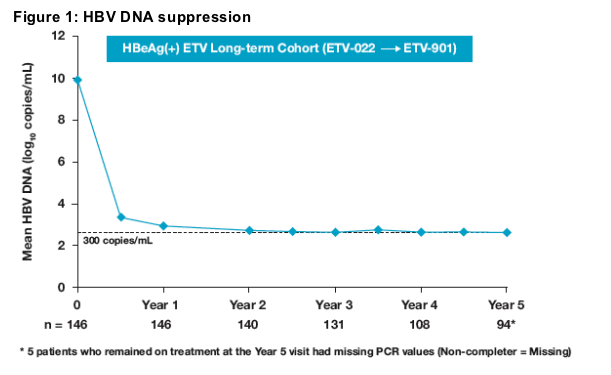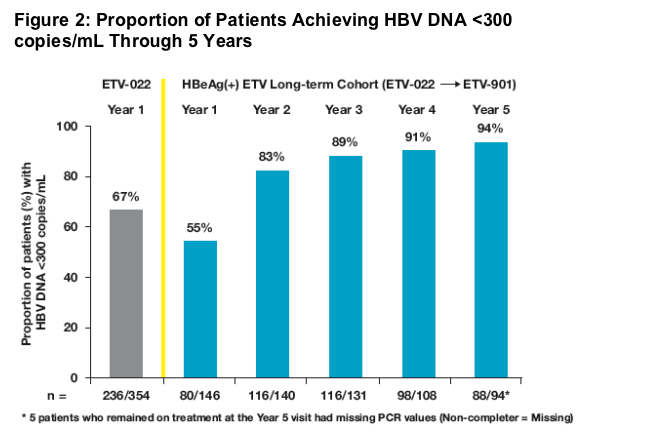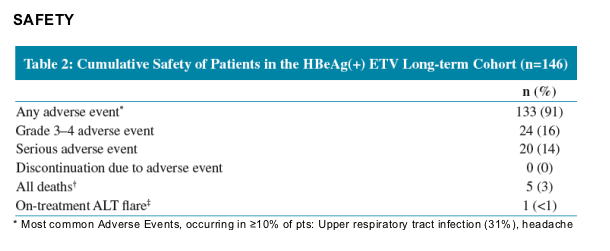 |
 |
 |
| |
Five Years of Continuous Entecavir for Nucleoside-naïve HBeAg(+) Chronic Hepatitis B: Results from Studies ETV-022/-901
|
| |
| |
Reported by Jules Levin
AASLD Nov 4 2008, San Francisco, CA
Steven-Huy B. Han1, Ting-Tsung Chang2, You-Chen Chao3, Seung Kew Yoon4, Robert G. Gish5, Hugo Cheinquer6, George E. Kitis7, Hui Zhang8, Uchenna Iloeje8
1Division of Digestive Disease, UCLA School Of Medicine, LA, California, USA; 2Department of Internal Medicine, National Cheng Kung University Medical College, Tainan, Taiwan; 3Neuro-Medical Scientific Center Departments, Buddhist Tzu Chi General Hospital, Taipei Branch, Taipei, Taiwan; 4Kangnam St. Mary's Hospital, Seoul, Korea; 5Division of Hepatology and Complex GI,
California Pacific Medical Center, San Francisco, California, USA; 6Universidade Federal Do Rio Grande Do Sul, Porto Alegre, Brazil; 7Department of Gastroenterology, Georgios Papanikolaou Hospital, Thessaloniki, Greece; 8Bristol-Myers Squibb Pharmaceutical Research Institute, Wallingford, USA
Author Summary of Results
Ninety four percent of nucleoside-naïve HBeAg(+) patients who received 5 years of continuous treatment with ETV had HBV DNA <300 copies/mL
Long-term treatment also resulted in maintenance of ALT normalization and incremental patients achieving HBeAg loss and HBe seroconversion
As previously reported, only one patient in this cohort developed genotypic resistance to ETV5
Safety profile remained consistent with the previously reported experience
Author Conclusion
Observations from this cohort demonstrate that long-term treatment with ETV results in durable suppression of HBV DNA replication
Durable suppression with long-term ETV results in regression of fibrosis/cirrhosis (see Poster 894)
Introduction
· The goals of treatment of chronic hepatitis B (CHB) are to achieve sustained suppression of hepatitis B virus (HBV) replication and remission of liver disease1
· Development of drug resistance poses a serious challenge to effective long-term treatment2
· Entecavir (ETV) 0.5 mg daily demonstrated superior virologic, histologic and biochemical activity compared to lamivudine (LVD) 100 mg daily in nucleoside-naïve HBeAg(+) CHB patients (study ETV-022)3
· Through 96 weeks, emergence of genotypic resistance to ETV was detected in only one patient4
· Patients who completed treatment in ETV-022 could enroll in the rollover study ETV-901
· We present long-term efficacy, safety and resistance data from a cohort of nucleoside-naïve patients from studies ETV-022 and ETV-901 who received up to 5 years of continuous therapy with ETV
Methods
Study population
The HBeAg(+) ETV Long-term Cohort consists of patients who:
- were initially treated with ETV in ETV-022
- subsequently enrolled in ETV-901 with a ≦35 day treatment gap between ETV- 022 and ETV-901

· The HBeAg(+) ETV Long-term Cohort is an observational cohort that was defined without regard to:
- treatment response at end of dosing in ETV-022
- HBV DNA, ALT measurements or HBV serology at the start of dosing in ETV 901
· Initially, due to ongoing blinding of Phase 2-3 studies, patients enrolling into study ETV-901 received a combination of ETV 1 mg and LVD 100 mg daily. Subsequently, the protocol was amended for patients to receive monotherapy with ETV 1 mg daily
Efficacy, safety and resistance analyses
· Efficacy assessments evaluated the proportions of patients who had evaluable samples at annual time points (Weeks 48, 96, 144, 192 and 240 [Non-completer = Missing]) for the following parameters:
- HBV DNA <300 copies/mL by PCR
- ALT ≦1 x ULN
- HBeAg loss
- HBe seroconversion
- HBsAg loss
· HBV DNA measurements were performed at a central laboratory; ALT measurements were performed at local laboratories. HBV serologies were performed at a central laboratory in ETV-022 and at local laboratories in ETV-901
· Patients in the HBeAg(+) ETV Long-term Cohort were part of the ETV resistance monitoring program5:
- Genotyping was performed on paired baseline and on-treatment samples from all patients who had:
· HBV DNA ≥300 copies/mL (50 IU/mL) at Years 1, 2, 3, 4, 5 or end of dosing
· virologic breakthrough (confirmed ≥1 log10 increase in HBV DNA from nadir) while on treatment
- Phenotypic susceptibility was performed for all:
· virologic breakthrough samples
· isolates with novel emerging substitutions
· Safety was assessed by the incidence of clinical adverse events (AEs) and laboratory abnormalities
RESULTS

Demographics and baseline characteristics for patients in the HBeAg(+) ETV Long-term Cohort were consistent with those of all treated patients in ETV-022
Exposure
Fourteen patients received ETV monotherapy only for a mean of 193 weeks (median 196 weeks); 132 patients received ETV and LVD combination therapy for a mean of 26 weeks (median 24 weeks) followed by ETV monotherapy for a mean of 194 weeks (median 221 weeks)
A total of 47 patients discontinued treatment before the Year 5 visit
The reasons for patient discontinuation included:
- subject withdrew = 14 (30%)
- completed Treatment = 12 (26%)
- death = 5 (11%)
- other = 16 (34%)
Among patients who discontinued treatment prior to the Year 5 visit, 37 (79%) had HBV DNA <300 copies/mL at their last visit


Results at Year 1 were consistent between the HBeAg(+) ETV Long-term Cohort (55%)
and the overall ETV-022 population (67%)
Treatment in Year 2 resulted in increasing proportions of patients achieving HBV DNA
<300 copies/mL
Continuous treatment through Years 3, 4 and 5 resulted in high proportions of patients
maintaining HBV DNA <300 copies/mL
ALT normalization
Results at Year 1 were consistent between the HBeAg(+) ETV Long-term Cohort (65%)
and the overall ETV-022 population (68%)
Treatment in Year 2 resulted in increasing proportions of patients achieving ALT
normalization (78%: 109/140)
Continuous treatment through Years 3, 4 and 5 resulted in maintenance of ALT
normalization (80%: at year 5)
Serologic response
· In ETV-022, 31% and 5% of patients achieved HBe seroconversion and HBsAg loss respectively through 120 weeks of on/off-treatment follow-up
· Due to protocol-defined management criteria, most patients who achieved HBeAg loss or HBe seroconversion in ETV-022 discontinued study therapy and did not enroll in the HBeAg(+) ETV Long-term Cohort
· Among the 146 patients in the HBeAg(+) ETV Long-term Cohort:
- Five patients achieved HBe seroconversion in ETV-022
- Continuous treatment of patients in this cohort resulted in 33 additional patients
achieving HBe seroconversion in ETV-901 (on treatment and during 6 months of
post-treatment follow-up)
- Similarly, one patient achieved HBsAg loss during treatment in ETV-022 and two addtional patients achieved HBsAg loss through continued treatment in ETV-901
Resistance analysis
One of the 146 patients in this cohort had ETV resistance (Year 3). This patient also experienced virologic breakthrough
- Among the 47 patients who discontinued ETV prior to the Year 5 visit, 10 patients had HBV DNA ≥300 copies/mL at the last on-treatment measurement
- Genotypic analysis showed that none had evidence of genotypic ETVr

References
1. Lok AS, McMahon BJ. Chronic hepatitis B. Hepatology 2007;45:507-539.
2. A CME-Certified Enduring Material: Monograph and Accompanying Slide Set. The International Forum on Resistance in the Treatment of Hepatitis B, Chicago, Illinois, March 3-4, 2007.
3. Chang TT, Gish RG, de Man R,et al. A comparison of entecavir and lamivudine for HBeAg-positive chronic hepatitis B. New Engl J Med 2006;354:1001-10.
4. Gish RG, Lok A, Chang TT, et al. Entecavir therapy for up to 96 weeks in patients with HBeAg-positive chronic hepatitis B. Gastroenterology 2007;133:1437-44.
5. Tenney D, Pokornowski KA, Rose RE, et al. Entecavir at Five Years Shows Long-Term Maintenance of High Genetic Barrier to Hepatitis B Virus Resistance. Hepatology
International 2008; 2(1): A88-89
|
| |
|
 |
 |
|
|